The PT2399 is one of the most rewarding chips a DIYer can experiment with. A stock circuit from the datasheet can nearly complete a guitar pedal project, and there are load of other applications for projects that require an analog-sounding digital delay (more on this later). For you circuit tweakers out there, I will include a Mods section to get you going in the right direction.
First off, let’s take a look at the datasheet to learn more about the PT2399.
PT2399 Datasheet
Always get a datasheet for any unfamiliar components before you do any circuit work! You don’t want to destroy your part before you get a chance to hear it!
Princeton, the company that manufacturers the PT2399 Echo Audio Processor IC, made a great datasheet to accompany their product. Unfortunately, the full version is hard to find amongst the most popular Google results for “PT2399 datasheet”; an abridged version that edits out the good and useful parts is abundant. Throughout this page, I will use snippets from the full datasheet to explain some of the results of my experience with the PT2399.
You can download the full datasheet below:
PT2399_datasheet_(full_version)
PT2399 Features
I’m not going to repeat the datasheet description/marketing here. What I will do is try and express how the PT2399 actually sounds.
The PT2399 has a lot of unique features. It’s a digital delay that mimics analog delays quite well, giving a warm bassy filter to the overall delay repeats. This is no accident, as the PT2399 has a lot of high-frequency digital noise that has a way of getting into the audio path and is tamed through filtering courtesy of the on-chip op amps.
If you use the PT2399 Echo Application’s Pin 6 resistor-potentiometer configuration,

you’ll notice that the input signal will modulate in pitch as you sweep the potentiometer. Whenever I see potentiometers, I think modification. See the Mods section later in this guide for some of the ideas you can try out!
“PT2399 boast of very low distortion (THD<0.5%)” – this number given by the datasheet authors is very suspicious given my own experience, but let your ears decide whether the distortion is acceptable. Circuit design is all about tradeoffs, and distortion can somewhat warm a tone up.
Because the PT2399 is CMOS, interfacing with this circuit is very experimenter-friendly. CMOS is a technology of ICs that, simply put, plays nice with other CMOS device. They’re often used for prototyping simple circuit in lieu of using a microcontroller. The familiar DIP packaging makes integrating it into through-hole designs an easy task. Be very careful handling your PT2399, as CMOS devices are prone to being damaged by static electricity.
The internal memory is limited to 44K, which overall limits the quality of the repeats at certain settings. The quality of the IC’s output noticeably degrades.
I’ll describe some more features in the future.
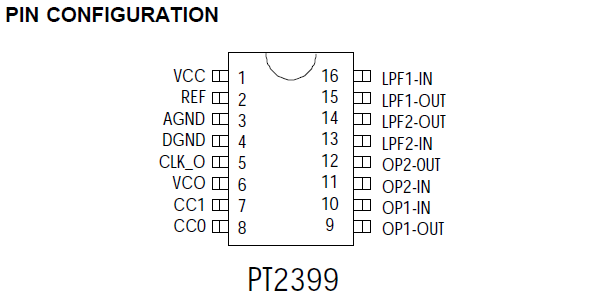


Basic Schematics
The following PT2399 circuit schematics are included in the datasheet for the chip.
The PT2399 Echo Application Circuit is a quick way to see what the PT2399 is all about. If you do not have the exact component values for the capacitors, get as close as you can. 0.082uF capacitors can be very difficult to obtain. The ‘R’ value is best set at 1k, and the 20k potentiometer next to it keeps you in a safe range of delay lengths.
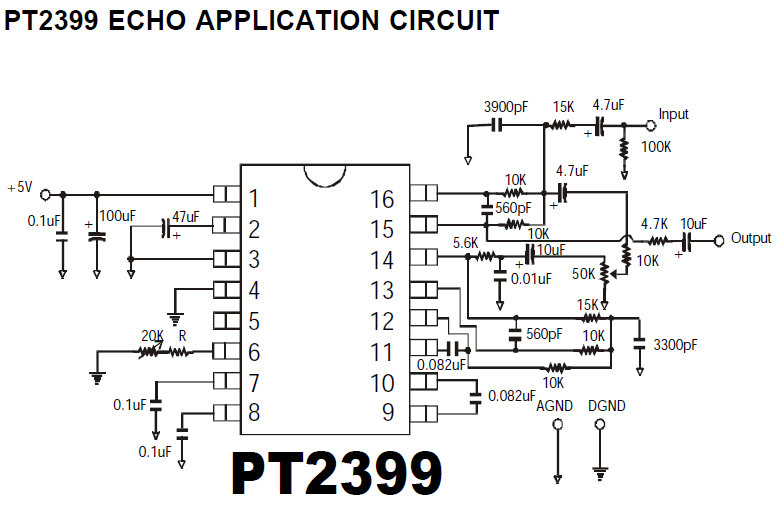
The second schematic Princeton has on their datasheet is the PT2399 Surround/Delay Application Circuit. I believe what they mean by ‘surround’ is reverb, which is actually sort of achievable (more on this later in the Mods section) if you set your circuit up right. Again, if you don’t have all the parts, just improvise; getting the circuit up and running is worth it!
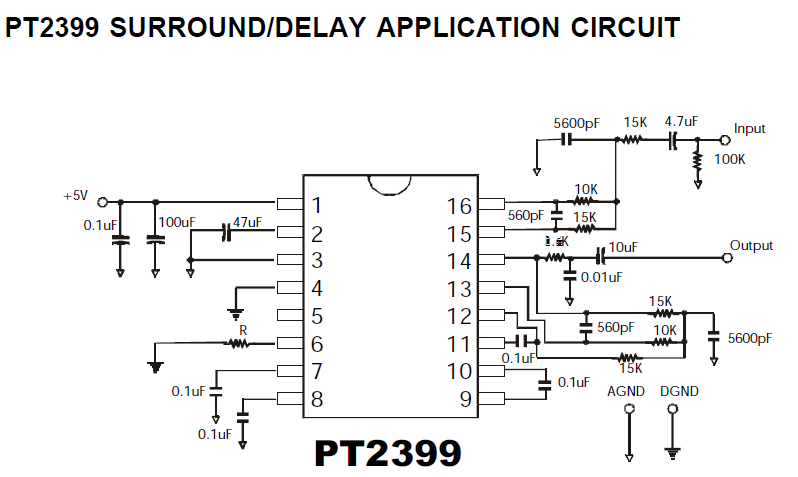
These are very good places to start. I prefer to build unfamiliar circuits piece by piece and bring them together once they are functioning correctly. Build a simple PT2399 circuit, test it, and integrate it with your next stage of development.
Advanced Schematics
Several great schematics are available online. Many of them have modifications that rival professional circuits, so you’re not going to get a hodgepodge of iffy designs.
- Valve Wizard’s Small Time – Valve Wizard did his homework when designing his PT2399 circuit. His insightful accompaniment to the Princeton datasheet and example circuit will shave off a couple of hours of frustration when you’re looking to tweak your circuits.
- Echo Base – If you were ever wondering what the design process looks and feels like, look no further. This 60+ page thread on the phenomenal DIY guitar pedal message board DIYStomboxes is a textbook example of what it takes to deal with a lot of issues on the way to perfection. The Echo Base PT2399-based circuit incorporates an LFO (low frequency oscillator) for delay length modulation as well as some other nifty features.
- I’ll be adding my own buffered guitar pedal with an in-depth analysis soon!
- Another experimental circuit I have in the works is the source of a lot of the Mods below. In a nutshell, an LFO controls the delay speed, which also controls the pitch of the signal being processed. It’s very similar to the Echo Base, but with more waveforms and a tweaked PT2399 circuit.
Mods
Datasheets are just recommendations, right?
For the most part, you’ll do fine in your electronics life if you stay in the bounds specified by electrical engineers who took the time to write down how their particular device works. However, sometimes you need to paint outside the lines…
For example, take a look at this datasheet snippet.
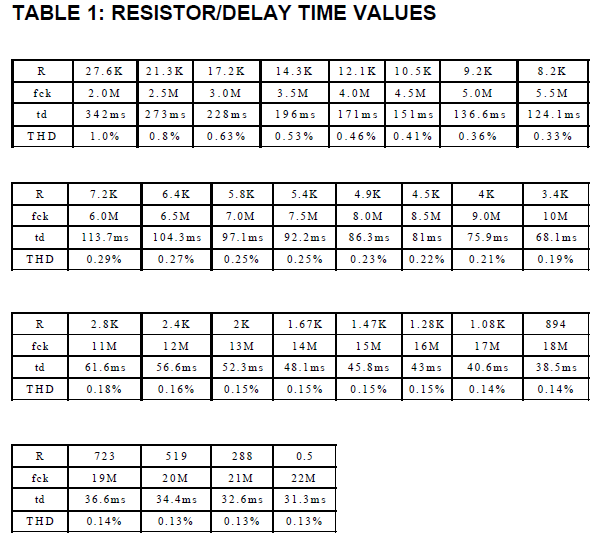
These are the ‘R’ values that Princeton suggests for their two example schematics.
NOTE: do not let the total resistance between Pin 6 and GND fall below 1k. Anything below that may cause the PT2399 to latch up, requiring a reset (turn to power to the IC off and then on again). Especially take care that the resistance is at least 1k or greater when the PT2399 first starts up (see datasheet application note below).
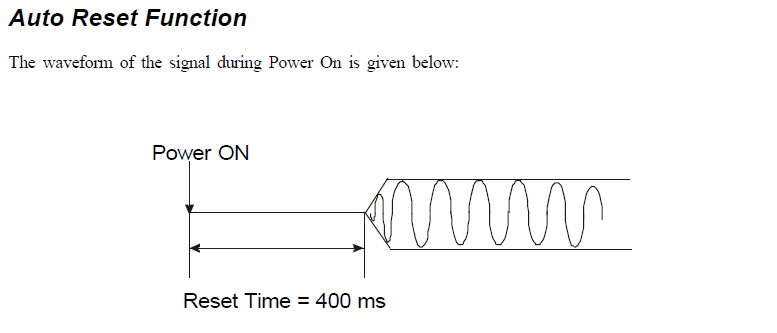
This is actually audible and a great lead-in to our next modification. So get your simple PT2399 circuit running, plug in a guitar and amplifier, and turn the power off, then on. What you will hear is a modulated delay with some pitch manipulation. Very cool!
Some links to other PT2399 Mod resources:
- Homebuilt Hardware – Towards the bottom, there is some info on using a CV (control voltage) source to modulate the delay speed/length. I have yet to test this, but it looks promising.
- More to come!
Real-World Examples
There are many great PT2399 projects out there! Many big-name companies (such as Danelectro & Korg) and smaller boutique guitar effects pedal manufactures use the PT2399 in their designs. Some of these schematics are available online for free from the manufacturer or reverse engineered, so you’ll have access to top-notch circuits if you do some research. I’ll post them as I find them (giving credit and avoiding the copyright infringement)!
Electronics Kits
Some electronics companies also offer kits for people that want to build their own delays around the PT2399 Delay IC:


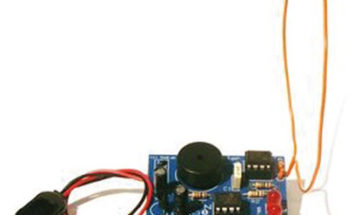
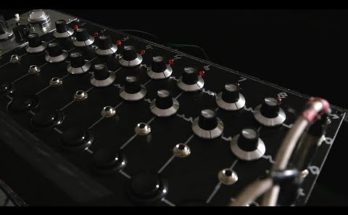
The circuit is wonderful!! For 747 l, could I use 4558?
To get a negative voltage for the I.c.’s in question, could I use 100k from positive and 100k from negative, the junction of which, would be decoupled by 100mfd and the junction point fed to supply a -ive voltage to the respective pins of the Ic’s. I am trying to in corporate lm 324 for Mike inputs on, including a wah wah circuit. I hope meet with success!???
The broken web page links can be fixed by visiting web.archive.org
I found this one for the digital delay
https://web.archive.org/web/20120622174544/https://www.freewebs.com/valvewizard2/smalltime.html
Hi, great post. If you want to experiment with PT2399 then I’d suggest to check ECHO Rockit by Ray Wilson at MusicFromOuterSpace. Spectacular use of modulation and clock speed.
great post
valve wizard website
http://www.valvewizard.co.uk/smalltime.html